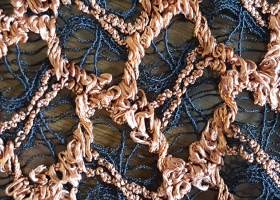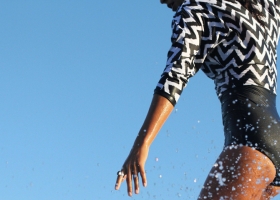
Intimoda Edit
Textifood
07 April 2016
After the repeated success of the Futurotextiles project, French association lille3000 presented Textifood...

...an exhibition within Futurotextiles presenting fibers of vegetable or animal origin, some of which are even suitable for human consumption, while others can be used for the textile industry. There were also products created from agro-food materials in collaboration with designers, stylists, design schools and companies. Curious enthusiasts were able to visit the Textifood exhibition in Milan, which took place from May 1 to July 14 2015 as part of the Expo 2015, whose slogan is “Feeding the Planet, Energy for Life”. Textile and agro-food production is just one part of the panorama of innovative fibers, often offering somewhat unusual inspiration, but nevertheless always useful for textile art.
Orange, lemon, pineapple, banana, coconut, nettle, coffee, rice, soy, corn, beet, flax, lotus, seaweed, mushrooms, wine, beer and shellfish... Textifood, the most recent of the Futurotextiles exhibitions, will present fibres made from plant or animal sources, whose non-edible by-products are used to create textiles. The aim of the Textifood exhibition is to showcase the range of synergies possible between food production and textiles. These fibres come from all continents. They are studied worldwide by researchers to find solutions for the needs of an increasingly responsible world. To illustrate the qualities of the frequently little-known fabrics made from these fibres, lille3000 has called on artists, designers and stylists aware of the need for an intelligent and sustainable use of the planet’s resources to come up with creations that incorporate fibres often derived from the by-products of crop production. Several artists have incorporated the research of textile companies based on plant chemistry and biomass processing; others have worked with natural fibres know for centuries but are all but forgotten nowadays. Whereas some researchers working in their laboratories have created innovative and entirely visionary materials.

Banana
A very special textile fibre can be extracted from banana petioles (the stalks at the base of the leaves). This very light and biodegradable banana silk is used in Japan, Nepal or the Philippines. In addition to its silky feel, this fabric is also very strong, flexible and waterproof. Banana fibre is dark brown or white depending on whether one takes it from the core or edge of the petioles. It requires close attention during weaving because its fibrous composition makes it very fragile and brittle. Em Riem trained in contemporary design when a student at the Ecole des Beaux-Arts in Saint Etienne and the Ecole Nationale superieure des Arts Decoratifs in Paris. He is the first artist to have opened a gallery in Phnom Penh (Cambodia). The use of local materials such as bamboo, rattan, or banana leaf, is an essential feature of his work. This dress made of dried banana leaves pasted on fabric is a perfect example of his style. Dita Sandico Ong has worked with banana silk for 15 years in the Philippines. The design and production process transforms the banana fibres into a lightweight fabric that transposes them into the world of high fashion.

The Lotus
At night, the closed lotus flower sinks below the surface of the water. At dawn, it opens again to rise toward sunlight. In Buddhism it symbolises the cycle of rebirth. The lotus seed is a frequently found foodstuff in traditional Asian cuisine. In Burma and Cambodia, lotus farms, such as Samatoa (Cambodia) use the lotus stem, whose fibres are composed of very long filaments, to make textiles. The long and difficult weaving process is done by hand at the Samatoa lotus farm in Cambodia. The fibres in the stem are used to produce a waterproof, incredibly lightweight and crease-resistant fabric. It gives an idea of how precious this fabric is! To showcase its properties, Maison Dognin Paris created a bag from an exclusive flexible leather method, the Canopée bag. Leather corner pieces amplify the volume of the fabric. In this way, it rises in three dimensions while retaining its qualities: lightness, softness and flexibility.

Fish
A kind of exotic freshwater carp, “Tilapia” are widely farmed and consumed around the world. The fish may be 5 to 50 centimetres in length. Umorfil Beauty Fiber(R) is a new textile fibre made out of collagen peptide derived from the scales of this fish and cellulose. Umorfil(R) retrieves these scales to produce a fibre with moisturising, anti-static and anti-UV qualities. French fashion designer Christine Phung worked for many highly prestigious brands before creating her own brand in 2011, and the textile designer Morgane Baroghel-Crucq, which creates materials derived from experiments and her research is based on the fusion of technical textiles with innovative materials: together they have created a dress with organic volumes for Textifood. This dress is hand-woven, made of metal thread, flax and fish collagen fibres, specially created for the event by the Umorfil company.“Exocet Dress” borrows its name from exocoetus, flying fish, whose metallic sheen and ability to fly out of the water suggest a link between sea, land and air.

Soy
Cultivated for its seeds, which are naturally rich in protein and oil, soy is used as a food source in equal measure for humans and animals. A vegetable fibre is derived from the soy plant’s protein, obtained by using residue from the soy production process: recovering the protein present in the seed which then undergoes several transformations (filtering, coagulation bath, etc.) to finally extract the soy fibre which is then woven. The result is an extremely fine and silky fabric, otherwise known as “plant cashmere” or “soy silk”. Based in Belgium, the Jules Clarysse company manufactures household linen from soy fibres recycled from soybean residues. Thanks to this new technology, towels dry faster and are more resistant to washing than ordinary towels. Kristian von Forselles is a Swedish fashion designer who has lived and worked in Paris since 2005. To make the Aurora Borealis dress, a surprising and futuristic creation, he teamed up with the Maison Darquer (Noyon Group), known as one of the oldest suppliers of Dentelle de Calais (R) in French haute couture. The Maison Darquer provided him with a lace made of viscose, polyamide and soy, specially created for the occasion. The dress and its accessories also feature a 100% pineapple-based, Sli-On fabric, crafted by textile designer Elodie Brunet and dyed with blue tea by Kristian Von Forselles.

Shells
Pinna Nobilis
The flesh of the Pinna nobilis is perfectly edible. It is even prized for its pungent flavour and aphrodisiac qualities. Byssus or “sea silk” comes from the Pinna nobilis, a large bivalve mollusc that produces filaments that, when put through a meticulous process – carding, washing and spinning – produce a fine, silky, and fireproof fabric. Today, the Pinna Nobilis is a protected species. Chiara Vigo, who is based in Sardinia, has developed a method of extracting the byssus without harming the living mollusc. She is now the only person in the world to perpetuate the tradition of weaving sea silk.

Citrus Fruits
Every year more than 700,000 tons of industrial waste are produced – in Italy – by the agro-food industry’s processing of citrus fruits. Orange Fiber, a research office based in Catania, Sicily, is working on the development of a textile from organic biomass, particularly from citrus fruit, in the laboratory of Milan Polytechnic. Created by the designer Godefroy de Virieu and landscape architects Virgile Desurmont and Louis de Fleurieu, the Bacsac company develops products whose primary function is to take better care of plants. Materials are selected to maintain the right balance between air, soil and water. The geotextiles or external technical fabrics, neutral for the soil and the plant, are breathable and resistant to weather hazards.

Coffee
Eco-friendly designer brand Herbe Rouge, supported by the Maisons de Mode label, was chosen for the somewhat difficult task of creating clothing entirely out of coffee - from the yarn to the final dyeing with ground coffee, which allows different shades of the coffee color to be obtained and makes the fabric soft to the touch. This collection, called “Torréfactions” (Roasting), was inspired by the process of production and consumption of coffee, as well as the roasting and grinding of coffee beans. Roasting allows green coffee beans without much flavor to be transformed into brown beans with a complex taste, consisting of more than 800 aromatic molecules. “Roasting” explains the exceptional properties of S.Café® yarns: they dry quickly, control odors and protect against UV rays; the space within the beans increases during the roasting, which gives a natural ease to the yarn. S.Café® yarns are bluesign® certified - a label that ensures minimum environmental impact during production. They have excellent technical characteristics for knitting, so the experts from Herbe Rouge have used the yarn to create haute couture styles with effects that are characteristic of coffee: they were twisted to achieve different densities that resemble the selection of coffee drinks (espresso, filtered, strong or not); these yarns are then knitted to create fabrics before being re-worked by hand to obtain a high quality finish of the entire product. Finally, the styles are given a final dye bath after a “coffee without heavy metals” dying process with coffee grounds, which gives them a new, natural color.

Beet and corn
The use of beet and corn represents a bio-revolution in the textile industry: a thread is manufactured from composite, biodegradable polymeric materials based on polylactic acid (or PLA) derived from the fermentation of sugar beet saccharin, but also from wheat, corn or potatoes. PLAs are obtained by extracting starch, which is converted into sugar. The sugar is then decomposed into lactic acid by microorganisms, this in turn being polymerized into a polylactide. Finally the polymer is extruded to produce a fibre. PLAs made from corn (polylactic polyesters) were originally intended for medical applications, but are now available as a textile fibre. The corn-based fabric it produces is creaseproof, smooth and soft. Specialised in innovative texture research and textile creation, A + Z Design Studio is constantly experimenting with new developments combining advanced technology and craftsmanship, and adhering to high ecological and hypoallergenic standards. Working in tandem with a chemist, the studio has won numerous awards for its research. For Textifood, Geneviève Levivier is experimenting with new nonwoven materials based on eggshells and corn and beet PLAs invented by Centexbel, the Scientific and Technical Centre for the Belgian Textile Industry. Her “bonne fée” (Good fairy) dress will be presented at the France Pavilion.

Beer - hops
With the technique of biosynthesis, it is possible to materialise beer fermentation and thus give it the appearance of a textile. The Beer Dress originated from the process of bacterial formation in beer. Gary Cass, an Australian researcher, has developed a material derived from the manufacturing process of beer, using it to make a dress inspired by the hop flower, designed by Donna Franklin.

Nettle
Although made from the stem of Urtica dioica, the “weed” familiar to our gardens, the only tingling sensation caused by this natural fibre is to stir our curiosity. The fabric it produces is as soft and as supple as linen. Indeed, nettles are not just found in soup any more, but also in certain textiles! Its strengths: the fibre, like the plant, is antiseptic and stimulating. Furthermore, it provides very good thermal insulation because it traps air in the fabric. Nina Gautier is a young Swiss designer whose research explores the many facets of the nettle. With her “Urtica-lab”she demonstrates the different substances and materials that can be obtained from this plant.

Baobab
The baobab tree, an emblem of tropical Africa, is put to many uses. All parts of this monumental tree serve a purpose: the wood of the trunk, the leaves, the fruit (also called monkey bread) and the bark. It is useful to both humans and animals, which can eat the leaves or seed cakes after they have been cold pressed for oil. As the inner part of the baobab bark is very fibrous, it is also used for making ropes. Wide strips of bark are cut out of the trunk and then beaten to extract the fibre. The designer Eric Raisina, born and raised in Madagascar, has always been fascinated by the beauty, strength and elegance of the Madagascar baobab. For Textifood, he focused on the texture of the baobab bark, a natural material that eerily mimics perforated lace or simply a nonwoven fabric. Strands of fibre are extracted from the bark and then woven with silk or crocheted. In line with his previous designs, Eric Raisina has created a unique piece that entices us to embark on a voyage.

Flax
With their faintly sweet taste and flavour reminiscent of nuts, flax seeds and the flax (or linseed) oil derived from them are used in many recipes. The flax fibres are extracted from the stem of the plant. The textile material is recovered in two steps: “retting”, which removes the cellular tissue between fibres, and “scutching”, which separates the fibres. This process gives rise to a raw product, the “tow”, which must be combed to remove fragments of stems and fibres that are too short. In addition to current uses (clothing, household linens, wall covering), the applications of flax are undergoing a revolution with the emergence of composite materials. The Texilis company, which has operated in the north of France for 3 years now, works with local scutchers to develop environmentally-friendly linen products. The walls of the Textifood exhibition are lined with one of Texilis’most recent innovations, the StarFlax Wall, a nonwoven wall lining made out of linen and viscose, both sourced in Europe. The originality of this plant fibre-based nonwoven fabric lies in the manufacturing process: hydroentanglement, a method using only the bonding force of high-pressure water jets. The StarFlax Wall has a high covering ability and is applied directly using a water-based glue. Flax is considered as the leading environmentally-friendly fibre; thanks to its technical properties it associates ecodesign, lightness and high mechanical performance. Specialising in the treatment of this material, the Dehondt Group recently manufactured an eco-designed electric vehicle corporating composite parts using flax fibres: the SCUBE(R). This three-wheel vehicle is an environmentally friendly means of transport: recyclable, quiet and very easy to handle. It is capable of transporting one person with a 40 km range (23 km/h).
Copyright 2024. All rights reserved - Terms






